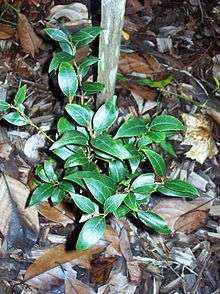Cryptocarya nova-anglica
Cryptocarya nova-anglica, the mountain laurel, is a rainforest tree growing in eastern Australia. The habitat is a restricted distribution in cool temperate rainforest mostly over 1,100 metres in altitude. The range of natural distribution is from the upper Hastings River to near the border of the state of Queensland. It is an understorey tree, associated with the Antarctic beech, possumwood, golden sassafras and black olive berry trees.
| Mountain laurel | |
|---|---|
 | |
| Scientific classification | |
| Kingdom: | Plantae |
| Clade: | Tracheophytes |
| Clade: | Angiosperms |
| Clade: | Magnoliids |
| Order: | Laurales |
| Family: | Lauraceae |
| Genus: | Cryptocarya |
| Species: | C. nova-anglica |
| Binomial name | |
| Cryptocarya nova-anglica | |
The specific epithet "nova-anglica" refers to the occurrence of this plant growing at New England National Park where it is most easily seen.
Description
A small to medium-sized tree, occasionally reaching 20 metres tall and a trunk diameter of 45 cm.[1] The base of the tree is not buttressed. The trunk is brown with some wrinkles and fissures. Small branches are fairly thick, orange or yellow and smooth. Buds covered in downy hairs.
Leaves are simple, alternate on the stem. Ovate-lanceolate in shape, 3 to 7 cm long, 1.6 to 3.5 cm wide[2] with a long drawn out tip. Shiny dark green above, and dull grey below. The cream midrib is depressed above the leaf and raised below. Leaf veins are straight, not curved from the midrib. Leaf stalks around 5 mm long.
Flowers, fruit & regeneration
Small creamy green flowers form in the months of December to January. The panicles or racemes are tiny, around 1 cm long, appearing from the leaf axils.
Fruit matures in March to April, taking some fifteen months to mature. It's a black drupe with a pointed tip, around 1 cm in diameter. Fairly round or pear shaped. Like many Cryptocarya fruit, the seed can be ribbed, but not with all seeds with this species. Removal of the flesh should be undertaken before planting the seed.
References
- Floyd, A.G. (2008). Rainforest Trees of Mainland South-eastern Australia. Inkata Press. p. 188. ISBN 978-0-9589436-7-3.
- "Cryptocarya nova-anglica". PlantNET — NSW Flora Online. Retrieved 2010-06-09.
External links
- "Cryptocarya nova-anglica B.Hyland & A.G.Floyd". Atlas of Living Australia.